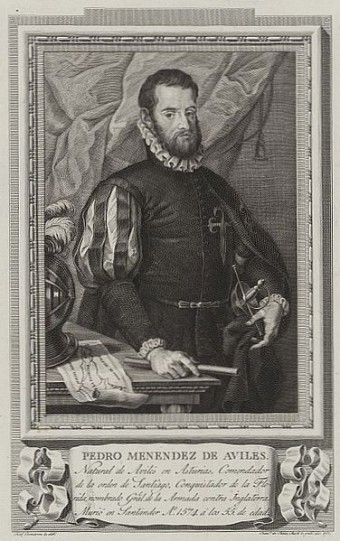This Day in History: August 28th
This Day In History: August 28, 1565
 The city of St. Augustine, Florida is the oldest permanently occupied European settlement in the United States, making both Jamestown and Plymouth look like Johnny-Come-Latelys by comparison.
The city of St. Augustine, Florida is the oldest permanently occupied European settlement in the United States, making both Jamestown and Plymouth look like Johnny-Come-Latelys by comparison.
Spanish explorer Pedro Menéndez de Avilés sighted land on August 28, 1565, the feast day of St. Augustine of Hippo. By September 7th, the Spanish had reached Matanzas Bay and disembarked, watched with much interest by the native Timucuan Indians. They had hopes of immediately digging a temporary fortification. Then they planned to take a more thorough survey of the surrounding area before deciding where to construct a permanent fort.
Menéndez was not the first to discover the area, nor was he the first to attempt colonization. Spanish explorer and Puerto Rican governor Ponce de Leon first spotted St. Augustine in 1513 while he was in search of the fabled Fountain of Youth. Ponce de Leon called the peninsula, which he incorrectly believed to be an island, “La Florida” or “Land of Flowers.”
Between 1513 and 1563, Spain made six attempts to colonize Florida. All six failed.
The French managed to establish a settlement and a fort in 1564 which galvanized the King of Spain, Phillip II, into action. He named (a bit preemptively it would seem) Admiral General Don Pedro Menéndez de Avilés Governor of Florida, ordering him to seize the land from pirates and settlers from other nations and colonize it in the name of Spain.
And that’s exactly what he did.
After putting the French in their place, Menendez set about the task of building the town of St. Augustine, building missions to convert the heathen natives and exploring/exploiting the land. For the remaining nine years of his life, he protected the fledgling community from the French and marauding pirates. After his death in 1574, his nephew Don Pedro Menendez Marquez took over as governor until 1589.
When the English had established themselves in the New World, Spain bankrolled the construction of a fort, The Castillo de San Marcos, to protect St. Augustine from attacks from the north. The stone fort took 23 years to complete, but became indispensable to the city’s defense.
In order to win back Cuba’s capital, in 1763 Spain ceded Florida to the English. This began a 20-year period of English rule in Florida that encompassed the years including the American Revolution. In 1783, control of Florida changed hands again – this time back to Spain. Then on July 10, 1821, Spain surrendered control of Florida to U.S. troops, and in 1845 it became the 27th state admitted to the union.
If you liked this article, you might also enjoy our new popular podcast, The BrainFood Show (iTunes, Spotify, Google Play Music, Feed), as well as:
- The Truth About the Bermuda Triangle
- The Mystery of the Coral Castle
- The Pilgrims Did Not Celebrate the First Thanksgiving in America
- From Desert to Party Central: The Birth of Las Vegas
| Share the Knowledge! |
|





Quoting from the article: “Ponce de Leon called the peninsula, which he incorrectly believed to be an island, ‘La Florida’ or ‘Land of Flowers.'”
Part of the above is inaccurate. The author, instead of doing the required research, must have copied the error from another poor source.
The truth is that Juan Ponce de Leon gave Florida its name on Easter Sunday of 1513. He called it “La Tierra de la Pascua Florida,” which means, “the Land of Flowery [or Flowering] Easter.” In his native Spain, Easter (even today famous for its profusion of lilies in many nations) was sometimes called the “Feast of the Flowers.”
Apparently the above fact has been ignored by many non-Christian or anti-Christian writers (who want to say nothing about Easter, when Jesus’s Resurrection is recalled), so the author of the present article failed to unearth them. Equally bad is the fact that she presented, as if it were a fact, something that is merely a myth, when she wrote, “Spanish explorer and Puerto Rican governor Ponce de Leon first spotted St. Augustine in 1513 while he was in search of the fabled Fountain of Youth.”
Besides the fact that there was no “St. Augustine” for Ponce to “spot,” serious historians now agree that his supposed “search” for such a “fountain” is as much a thing of fiction as the fountain itself. He was actually in search of other things (things more mundane).